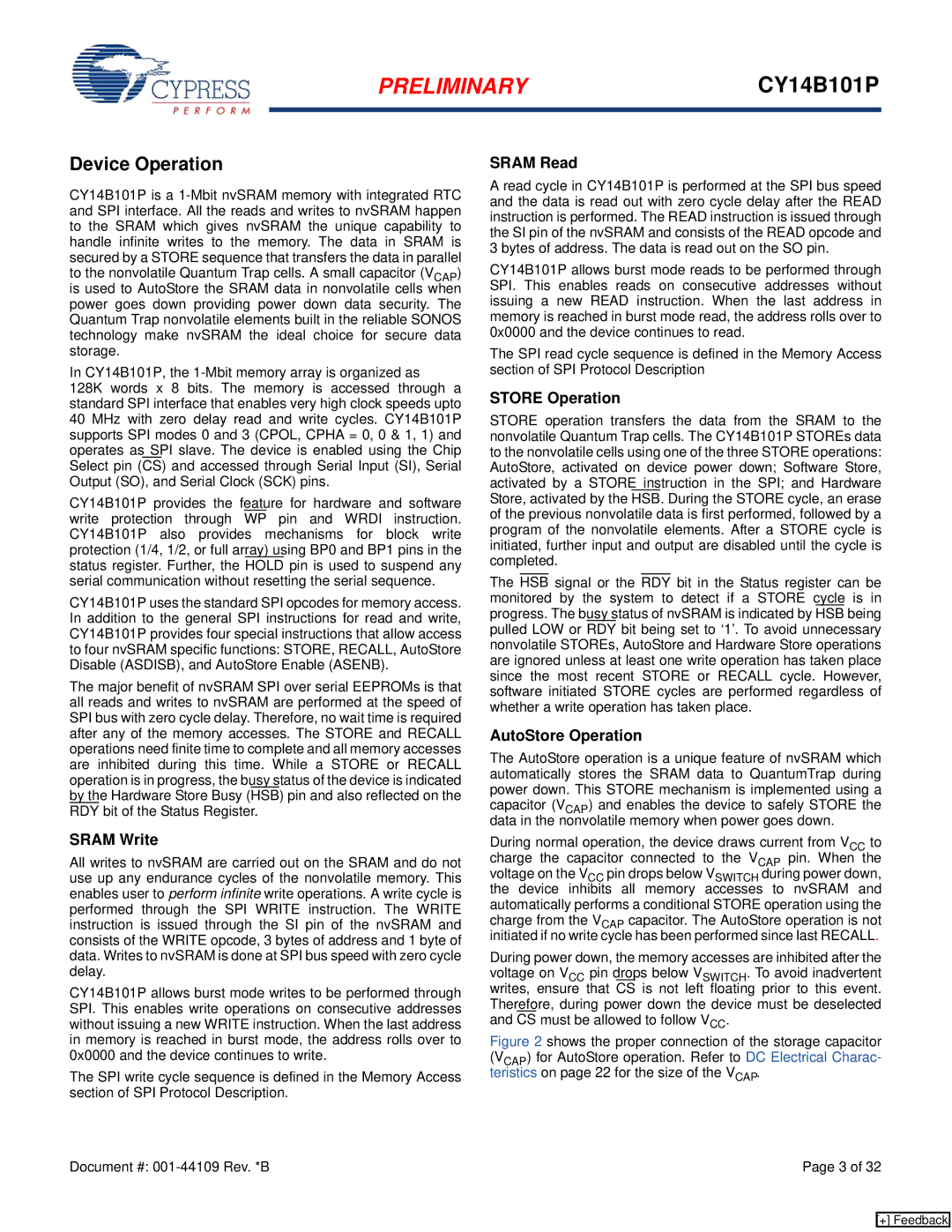
PRELIMINARYCY14B101P
Device Operation
CY14B101P is a
In CY14B101P, the
128K words x 8 bits. The memory is accessed through a standard SPI interface that enables very high clock speeds upto 40 MHz with zero delay read and write cycles. CY14B101P supports SPI modes 0 and 3 (CPOL, CPHA = 0, 0 & 1, 1) and operates as SPI slave. The device is enabled using the Chip Select pin (CS) and accessed through Serial Input (SI), Serial Output (SO), and Serial Clock (SCK) pins.
CY14B101P provides the feature for hardware and software write protection through WP pin and WRDI instruction. CY14B101P also provides mechanisms for block write protection (1/4, 1/2, or full array) using BP0 and BP1 pins in the status register. Further, the HOLD pin is used to suspend any serial communication without resetting the serial sequence.
CY14B101P uses the standard SPI opcodes for memory access. In addition to the general SPI instructions for read and write, CY14B101P provides four special instructions that allow access to four nvSRAM specific functions: STORE, RECALL, AutoStore Disable (ASDISB), and AutoStore Enable (ASENB).
The major benefit of nvSRAM SPI over serial EEPROMs is that all reads and writes to nvSRAM are performed at the speed of SPI bus with zero cycle delay. Therefore, no wait time is required after any of the memory accesses. The STORE and RECALL operations need finite time to complete and all memory accesses are inhibited during this time. While a STORE or RECALL operation is in progress, the busy status of the device is indicated by the Hardware Store Busy (HSB) pin and also reflected on the RDY bit of the Status Register.
SRAM Write
All writes to nvSRAM are carried out on the SRAM and do not use up any endurance cycles of the nonvolatile memory. This enables user to perform infinite write operations. A write cycle is performed through the SPI WRITE instruction. The WRITE instruction is issued through the SI pin of the nvSRAM and consists of the WRITE opcode, 3 bytes of address and 1 byte of data. Writes to nvSRAM is done at SPI bus speed with zero cycle delay.
CY14B101P allows burst mode writes to be performed through SPI. This enables write operations on consecutive addresses without issuing a new WRITE instruction. When the last address in memory is reached in burst mode, the address rolls over to 0x0000 and the device continues to write.
The SPI write cycle sequence is defined in the Memory Access section of SPI Protocol Description.
SRAM Read
A read cycle in CY14B101P is performed at the SPI bus speed and the data is read out with zero cycle delay after the READ instruction is performed. The READ instruction is issued through the SI pin of the nvSRAM and consists of the READ opcode and 3 bytes of address. The data is read out on the SO pin.
CY14B101P allows burst mode reads to be performed through SPI. This enables reads on consecutive addresses without issuing a new READ instruction. When the last address in memory is reached in burst mode read, the address rolls over to 0x0000 and the device continues to read.
The SPI read cycle sequence is defined in the Memory Access section of SPI Protocol Description
STORE Operation
STORE operation transfers the data from the SRAM to the nonvolatile Quantum Trap cells. The CY14B101P STOREs data to the nonvolatile cells using one of the three STORE operations: AutoStore, activated on device power down; Software Store, activated by a STORE instruction in the SPI; and Hardware Store, activated by the HSB. During the STORE cycle, an erase of the previous nonvolatile data is first performed, followed by a program of the nonvolatile elements. After a STORE cycle is initiated, further input and output are disabled until the cycle is completed.
The HSB signal or the RDY bit in the Status register can be monitored by the system to detect if a STORE cycle is in progress. The busy status of nvSRAM is indicated by HSB being pulled LOW or RDY bit being set to ‘1’. To avoid unnecessary nonvolatile STOREs, AutoStore and Hardware Store operations are ignored unless at least one write operation has taken place since the most recent STORE or RECALL cycle. However, software initiated STORE cycles are performed regardless of whether a write operation has taken place.
AutoStore Operation
The AutoStore operation is a unique feature of nvSRAM which automatically stores the SRAM data to QuantumTrap during power down. This STORE mechanism is implemented using a capacitor (VCAP) and enables the device to safely STORE the data in the nonvolatile memory when power goes down.
During normal operation, the device draws current from VCC to charge the capacitor connected to the VCAP pin. When the voltage on the VCC pin drops below VSWITCH during power down, the device inhibits all memory accesses to nvSRAM and automatically performs a conditional STORE operation using the charge from the VCAP capacitor. The AutoStore operation is not initiated if no write cycle has been performed since last RECALL.
During power down, the memory accesses are inhibited after the voltage on VCC pin drops below VSWITCH. To avoid inadvertent writes, ensure that CS is not left floating prior to this event. Therefore, during power down the device must be deselected and CS must be allowed to follow VCC.
Figure 2 shows the proper connection of the storage capacitor (VCAP) for AutoStore operation. Refer to DC Electrical Charac- teristics on page 22 for the size of the VCAP.
Document #: | Page 3 of 32 |
[+] Feedback
